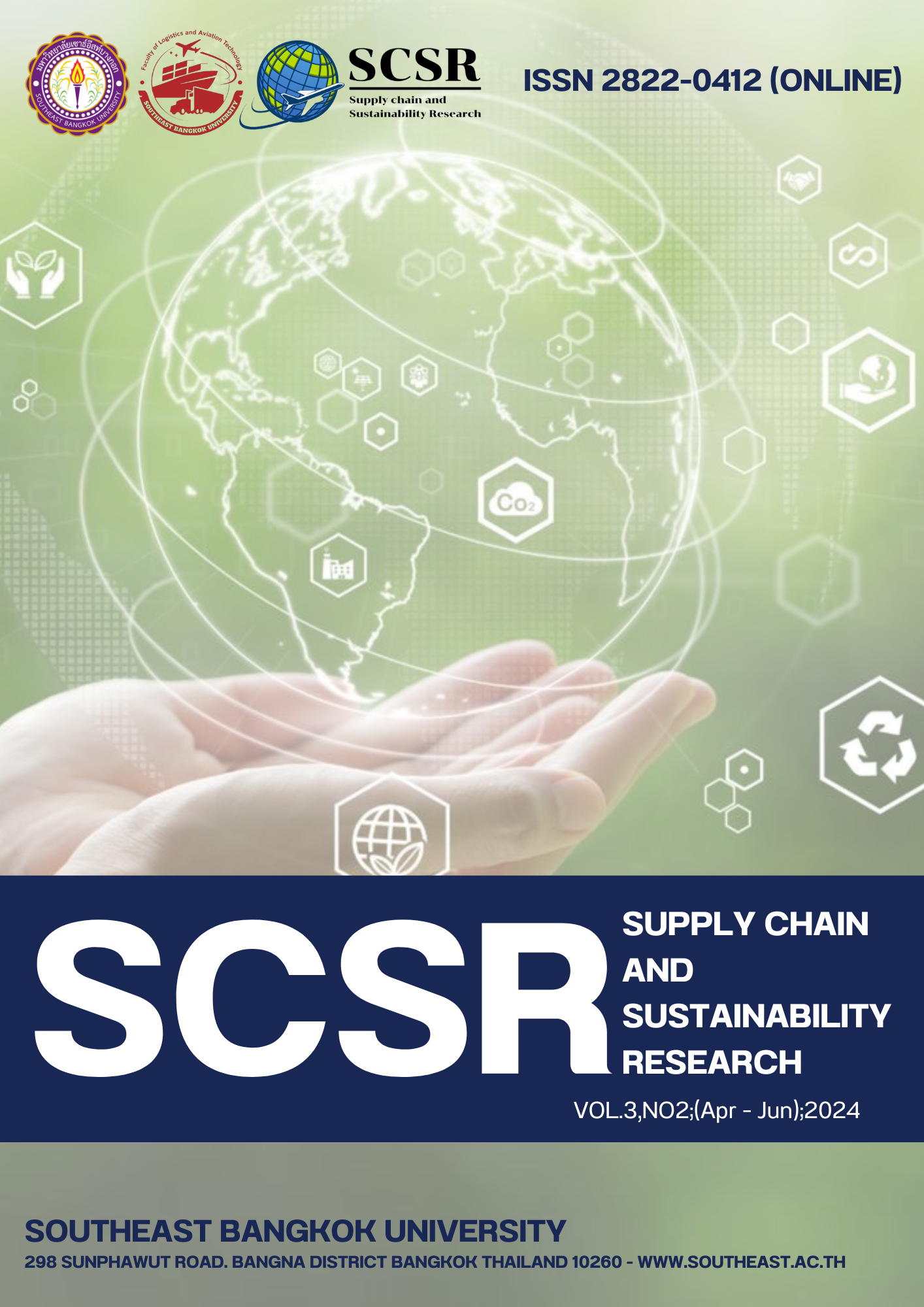Integrating Carbon Credits into Supply Chain Decision Simulations: Environmental Analysis and Business Strategy Discourse
Main Article Content
บทคัดย่อ
As global concerns about carbon emissions continue to escalate, effective carbon emission management has become a crucial aspect of business operations. This study aims to develop a simulation system centered on enterprises, incorporating carbon emission trading dynamics into comprehensive decision-making frameworks. Through environmental analysis, decision-making processes, and target management, this paper systematically models the business environment for enterprises under carbon emission constraints. Additionally, it explores the influence of carbon credit mechanisms on business strategies. The simulation system endeavors to serve as an experimental platform for researchers and business managers, enabling them to conduct simulation tests and refine strategies. Ultimately, it seeks to help enterprises navigate the challenges of carbon emission management and achieve mutually beneficial outcomes for both the environment and the economy.
Article Details

อนุญาตภายใต้เงื่อนไข Creative Commons Attribution-NonCommercial-NoDerivatives 4.0 International License.
บทความนี้ได้รับการเผยแพร่ภายใต้สัญญาอนุญาต Creative Commons Attribution-NonCommercial-NoDerivatives 4.0 International (CC BY-NC-ND 4.0) ซึ่งอนุญาตให้ผู้อื่นสามารถแชร์บทความได้โดยให้เครดิตผู้เขียนและห้ามนำไปใช้เพื่อการค้าหรือดัดแปลง หากต้องการใช้งานซ้ำในลักษณะอื่น ๆ หรือการเผยแพร่ซ้ำ จำเป็นต้องได้รับอนุญาตจากวารสารเอกสารอ้างอิง
Bernarto, I., Berlianto, M. P., Meilani, Y. F. C. P., Masman, R. R., & Suryawan, I. N. (2020). The influence of brand awareness, brand image, and brand trust on brand loyalty. Jurnal Manajemen, 24(3), 412-426.
Flood, M. M. (1952). On game-learning theory and some decision-making experiments (p. 0040). Rand Corporation.
He, B., Liu, Y., Zeng, L., Wang, S., Zhang, D., & Yu, Q. (2019). Product carbon footprint across sustainable supply chain. Journal of Cleaner Production, 241, 118320.
Jia, Z., & Lin, B. (2020). Rethinking the choice of carbon tax and carbon trading in China. Technological Forecasting and Social Change, 159, 120187.
Larson, K. (2019). The corporate playground: a review on game-based learning in enterprise training. In E-Learn: World Conference on E-Learning in Corporate, Government, Healthcare, and Higher Education (pp. 737-748). Association For the Advancement of Computing in Education (AACE).
Li, G., Wang, X., Su, S., & Su, Y. (2019). How green technological innovation ability influences enterprise competitiveness. Technology in Society, 59, 101136.
Li, J., Lin, Y., Sun, M., & Shadiev, R. (2023). Socially shared regulation of learning in game-based collaborative learning environments promotes algorithmic thinking, learning participation and positive learning attitudes. Interactive Learning Environments, 31(3), 1715-1726.
Li, T. T., Wang, K., Sueyoshi, T., & Wang, D. D. (2021). ESG: Research progress and future prospects. Sustainability, 13(21), 11663.
Masson-Delmotte, V., Zhai, P., Pörtner, H. O., Roberts, D., Skea, J., & Shukla, P. R. (2022). Global Warming of 1.5 C: IPCC special report on impacts of global warming of 1.5 C above pre-industrial levels in context of strengthening response to climate change, sustainable development, and efforts to eradicate poverty. Cambridge University Press.
Mayer, I., Warmelink, H., & Bekebrede, G. (2013). Learning in a game-based virtual environment: a comparative evaluation in higher education. European Journal of Engineering Education, 38(1), 85-106.
Milosz, E., & Milosz, M. (2014). Small computer enterprise on competitive market–decision simulation game for business training of computer science specialist. In ICERI2014 Proceedings (pp. 1831-1838). IATED.
Mishan, E. J., & Quah, E. (2020). Cost-benefit analysis. Routledge.
Nadolny, L., & Halabi, A. (2016). Student participation and achievement in a large lecture course with game-based learning. Simulation & Gaming, 47(1), 51-72.
Penz, E., & Polsa, P. (2018). How do companies reduce their carbon footprint and how do they communicate these measures to stakeholders?. Journal of Cleaner Production, 195, 1125-1138.
Rizan, C., Bhutta, M. F., Reed, M., & Lillywhite, R. (2021). The carbon footprint of waste streams in a UK hospital. Journal of Cleaner Production, 286, 125446.
Seo, K., Tang, J., Roll, I., Fels, S., & Yoon, D. (2021). The impact of artificial intelligence on learner–instructor interaction in online learning. International journal of educational technology in higher education, 18, 1-23.
Schrader, C., & Bastiaens, T. J. (2012). The influence of virtual presence: Effects on experienced cognitive load and learning outcomes in educational computer games. Computers in Human Behavior, 28(2), 648-658.
Wang, W., & Zhang, Y. J. (2022). Does China's carbon emissions trading scheme affect the market power of high-carbon enterprises?. Energy Economics, 108, 105906.
Wiedmann, T., & Minx, J. (2008). A definition of ‘carbon footprint’. Ecological economics research trends, 1(2008), 1-11.
Wu, W. H., Hsiao, H. C., Wu, P. L., Lin, C. H., & Huang, S. H. (2012). Investigating the learning‐theory foundations of game‐based learning: a meta‐analysis. Journal of Computer Assisted Learning, 28(3), 265-279.
Ziabina, Y., & Dzwigol-Barosz, M. (2022). A Country's Green Brand and the Social Responsibility of Business. Virtual Economics, 5(3), 31-49.


